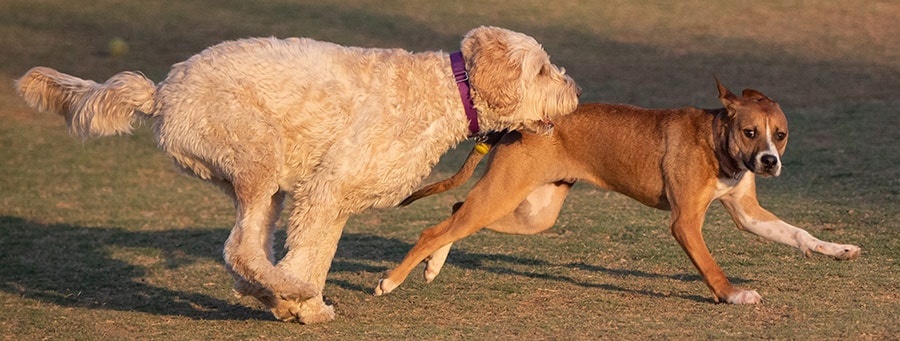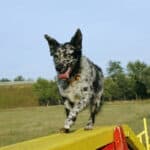
The Labradoodle is an intelligent, attractive and loving dog that has become very popular with people of all ages.
Learning as much as possible about Labradoodles can make owning one a rewarding experience for many years.
The Labradoodle is a crossbreed dog, created by mixing the Labrador Retriever and the Poodle with the intent to have an intelligent but hypoallergenic guide dog with excellent temperament.
The result was an affectionate, low-shedding dog with the Poodle’s intelligence and the Labrador Retriever’s sociable and love-of-people personality.
Labradoodles are average-size dogs that, with proper socialization and training, make excellent family pets, watchdogs, or all-around companion dogs.
The qualities that make Labradoodles such wonderful pets include:
- Mellow temperament – You’re bound to notice their easy-going and fun-natured spirit, handed down from their Labrador side.
- Intelligent – A result of being bred from two extremely intelligent breeds; the Poodle and Labrador Retriever.
- Loyal – Carrying a deep connection with their owner and family unit.
- Easy to train – A combination of their high level of intelligence and their desire to please their people.
- Playful – Always up for a game of chase, fetch, or even a swim.
- Easy to maintain – With good grooming, diet, and exercise routines, they are a pretty easy breed to care for.
At one time, the name Labradoodle was totally unheard of, but that is no longer the case because this particular breed of dog has become very popular.
Whether a person is looking for a pet, a working dog, a companion or a watchdog, they’re sure to find a Labradoodle that can fit the bill.
As an owner of 2 Labradoodles myself, I know how tough it can be to find good information. In the 60+ pages of this book, I share the information, resources, and breed-specific tips I wish I’d had from the start. You will save you time, money, and loads of frustration…take my word for it!
Considering getting a Labradoodle? Have a new Labradoodle puppy?
I’ve packed my personal experiences owning two Labradoodles into this complete owner’s guide to the breed.
You’ll learn everything concerning their temperament and basic care, as well as details on:
- Working with a breeder or adopting.
- Puppy proofing.
- Exercising their bodies and their minds.
- Socialization.
- Crate training, housebreaking, and basic commands.
- Health and nutrition.
- Shedding and grooming.
For anyone thinking about adding a Labradoodle to their family, this book is a necessity and will quickly become your go-to solution when questions arise.
Energy Level
The Labradoodle’s energy level can vary from one dog to the next.
While it would be rare to find a Labradoodle with low energy, their energy level can range from medium energy to high energy.
Either way, prepare for lots of walks and backyard exercise sessions. Fetch seems to be a particular favorite way to burn off energy.
You may want to invest in a ball launching device, (this one is awesome), or you might find that your arm is completely wiped out from throwing the ball again and again.
Best of all – you never have to touch the slobbery ball!
The variance in energy comes because the Labradoodle is a mixture of Poodle and Labrador Retriever.
When you’re mixing two different breeds of dog, you’re going to get a little from each breed.
Labrador Retrievers can be very laid back and mellow but, like most working dogs, can still have a good energy drive.
Miniature or Standard Poodles, which make up half the DNA of the Labradoodle, typically are high-energy dogs.
Regardless of which side the energy comes from or what percentage comes from each breed, Labradoodles are loaded with energy.
Labradoodles are always in need of some action. Much of this comes from the Labrador Retriever, which was bred for hunting, retrieving, and herding.
Because of their energy level, it’s essential that they get sufficient exercise on a daily basis. Find out how much exercise they need here.
I don’t like hearing that people shouldn’t have a specific breed of dog because of where they live.
With that said, apartment living isn’t ideal for the Labradoodle, but it’s possible as long as the dog gets 30 minutes to 60 minutes of good exercise every day.
The ideal location for this dog is a home with a large fenced-in yard so the dog can run, run, and run some more.
Some Labradoodle owners with the necessary time enroll their Labradoodles into training, competitions, and dog sports like flyball, rally, or agility.
We’re hoping to get our Labradoodle, Oliver, into agility — he already has the jumping over things part mastered.
The Labradoodle’s energy drive and desire to please their owner makes them perfect dogs for training.
Labradoodles need not only exercise but also mental stimulation (don’t miss our complete guide to exercising your dog’s mind).
They love playing catch, running free, and just checking out new sights and smells.
Failure to give your Labradoodle sufficient exercise and stimulation can result in boredom, excess barking, and destructive behavior, like chewing on things that should not be chewed!
Tons of physical, mentally challenging activities and fun game ideas can be found in this article.
Socialization with Children
Labradoodles are very sociable dogs and generally love being around children.
They love being around people in general, but their desire to play gives them a particular affection for children.
Like children, Labradoodles are always ready to play, whether it’s rolling around in the yard, chasing a ball, or just rough-housing in the family room.
Depending on if the Labrador Retriever was mixed with a miniature, medium-size, or standard Poodle, their weight can range anywhere from 15 pounds to 100 pounds.
(Our article on Labradoodle sizes and weights gives you specific details on what to expect and explains why their sizes vary so much.)
A Labradoodle in the mid-weight range can easily and unintentionally knock down and hurt a young child if unattended.
While hurting the child is definitely not the dog’s intent, it can happen if and when the dog starts running and jumping on the child.
Much of this sort of behavior can be eliminated with proper and consistent training.
This is often the case when a Labradoodle is suddenly put outside in a spacious yard and allowed to run around after being cooped up all day.
Some of the best-behaved dogs just seem to let loose those first couple minutes after being let out.
Labradoodles make excellent watchdogs for many families but not guard dogs. Labradoodles would often rather smell and lick a child than cause the child harm.
It’s also their great socialization skills and mild temperament that make Labradoodles ideal pets for first-time dog owners.
The best way to ensure the Labradoodle socializes well with children is to provide the dog with lots of opportunities to socialize at a very young age.
This combined with training at a young age can teach the dog how to socialize with children. Children and dogs that grow up together usually develop life-long bonds.
Be sure to check out our Complete Socialization Guide to make sure that you’re covering all aspects of this important part of raising a well-adjusted dog.
Socialization with Dogs and Other Animals
Labradoodles not only make great first-time pets but they also make great second pets because of their exceptional personalities and ability to get along with everyone.
They generally get along well with other dogs and pets in the family.
They love playing with people and other dogs, so they’re happy to be part of the group.
Labradoodles are amazing to watch when they’re around family members and suddenly see another dog.
In a moment’s time, the Labradoodle can go from quietly lying with his or her head on your lap to jumping up and running to catch a ball or chase the other dog.
With their excitable nature and easy-going temperament, Labradoodles generally approach each new animal they meet with the same happy enthusiasm.
As is the case with most dogs, when the Labradoodle is introduced to other dogs, cats, or animals at a young age, he or she is much more likely to socialize well with them.
When the Labradoodle is taken outside for exercise, the dog should be taken to places where there will be contact with other dogs and animals.
This should also start at a very young age. Dog training programs usually consist of several parts, and socializing with other dogs is a significant part of the program.
Interaction With Strangers
Labradoodles usually interact with strangers in the same way they interact with everyone else, which is very well.
If they’re inside the home, they’ll bark to alert their owners that someone is at the door, but they don’t generally pose much of a threat to the visitor because they love people so much.
They would also rather make friends with strangers than alert their owners that a stranger has come to the door.
Labradoodles may have the Poodle’s intelligence, but they also have the Lab’s mellow and friendly personality.
It’s not unusual to see a Lab lying down and barely lift his or her head when someone enters the room.
Remember that Labradoodles are half Lab, so they are going to have many of their traits.
When it comes to temperament, personality, and friendliness, the Labradoodle really does bring out the best of both breeds.
Also contributing to these positive traits is that most Labradoodles today are second-generation bred dogs.
What this means is that, while they may have originated from breeding a Labrador with a Poodle, today they mostly result from bringing a Labradoodle to another Labradoodle.
Head over to “What Is a Multi-Generational Labradoodle?” to demystify some of the terminology regarding generations and learn of the advantages to these breedings.
As is the case with meeting other animals and children, interaction and socialization with strangers should start at an early age when the Labradoodle is still a puppy.
Trainability And Intelligence
Labradoodle dogs are known for possessing many wonderful qualities, but the one adjective most used to describe Labradoodles is intelligent.
This should come as no surprise since both Poodles and Labrador Retrievers are both known for their intelligence.
Because they’re a combination of both breeds, no two Labradoodles are going to be exactly the same.
One might possess more Labrador-like qualities, such as late maturity, rowdiness, intelligence, and loyalty.
Another Labradoodle may possess more Poodle-like qualities, such as intelligence, great watchdog tendencies, and less shedding of hair.
Regardless of which one they tend to be more like, Labradoodles are brilliant, loving dogs that are easy to train.
(Learn just how easy and important training tips in this article.)
They do tend to have a personality where they want to be the ones in control, but with consistency and persistence, they are very trainable.
I am a firm believer that raising a good dog that behaves well is 50% DNA and 50% training.
The Labradoodle’s high intelligence and trainability have made them sought-after working dogs of various type, that are highly in demand throughout the world.
Guard Dog
Despite their great watchdog abilities, their friendliness and love of people do not make them good guard dog material.
This is not to say it’s impossible to have a Labradoodle as a guard dog; it’s just not something you see often or that they’re naturally cut out for.
Watch Dog
Labradoodles do make excellent watchdogs though.
Their love of their family members, their loyalty, and their alertness combine making them the ideal dog to watch your family and alert you to visitors.
If you want a watchdog that barks, I don’t think you’ll be disappointed with the Labradoodle.
Family Dog
There are few dogs that make as good of a family dog as Labradoodles. Labradoodles have all the qualities we want to see in a family dog.
-
- Friendly and welcoming
- Playful
- Loyal
- Loving
- Gentle temperament
Service Dog
Labradoodles are widely used as service dogs due to their intelligence, loyalty, and ability to learn so quickly.
These intelligent dogs are used in many capacities and by many types of people. Some areas where Labradoodles are commonly used include:
-
- Guide for the blind.
- Therapy dog.
- Blood sugar alert dog.
- Working guide dog.
- Wheelchair assisted therapy dog.
- Abused children therapy dog.
As you can see, Labradoodles are all-around fantastic dogs. There’s no doubt about that.
However, there’s still a lot more to know about the breed if you’re considering bringing one home.
Missing out on our book, “The Owner’s Guide To The Perfect Labradoodle” may not be the end of the world, but it might put you at a disadvantage.
Get the best start possible and set your dog up for success by arming yourself with as much knowledge as possible.
Related Questions:
At what age should Labradoodles begin basic obedience training?
I’ve always believed that it’s never too young to begin training your Labradoodle or any pup for that matter.
As soon as you bring your Labradoodle home, which is usually around 8 weeks of age, you can begin teaching him or her simple commands.
Don’t expect much the first couple of days because the puppy will need some time to acclimate to his or her new surroundings and new family.
Housebreaking a puppy is a certain type of obedience training because you’re teaching the pup that he or she must go to the bathroom outside or in a designated area.
It may not seem like discipline to you, but it is to the pup. You’ll want to teach your Labradoodle puppy simple commands as early as possible.
Whether you choose to train with treats or positive reinforcement (praise and play), the training should start off short and straightforward.
However, the training should be every day and should be consistent.
If you skip a few days, the puppy is likely to forget what he or she learned last week. This can lead to frustration for you and your pup.
Labradoodles are very intelligent and will catch on quickly with consistent and loving training.
There is nothing your Labradoodle wants more than to spend time with you and make you happy.
While there are many things you can teach your Labradoodle as the dog ages, it’s important to teach some fundamental but straightforward commands.
These are commands that could potentially save the dog’s life:
- Sit
- Come
- Stay
- Down
- Leave it
If I get a second Labradoodle, will they both get along?
There is no reason why two Labradoodle puppies shouldn’t get along with proper training and socialization.
This is particularly true if they are spayed or neutered at a young age, such as 8 to 24 weeks old, before they develop an “alpha” personality.
While it shouldn’t make a difference if it’s two males, two females, or a male and a female, it can make a slight difference depending on the individual dog.
Keep in mind that this is not always the case, but two males or a male and a female typically get along better in the same household than two females.
Male Labradoodles tend to have a “go with the flow” attitude, whereas females often are more specific.
This is not to say that two females will not get along well in the same house. A lot of it has to do with training at an early age.
The owner should show the young pups, male and female, that specific behavior is unacceptable, and they should be taught this early and often.
I have always preferred female dogs because I feel they’re more loving and more protective.
Friends I know swear that males are more loyal and not so much “Velcro dogs” like female dogs.
Deciding whether to get females or males often comes down to personal preference.
Are Labradoodles susceptible to any diseases?
The life span of Labradoodles is 12 to 15 years, which would indicate that they are relatively healthy dogs.
As unfortunate as this may be, every breed of dog has some illnesses or diseases in which they are susceptible or prone to developing, and the Labradoodle is no exception.
Because this “hybrid” dog is part Labrador Retriever and part Poodle, the dog is prone to develop illnesses or conditions that stem from both breeds.
Here are some of the most common diseases found in Labradoodles.
Hip Problems
Large dogs like Labradors often develop hip problems, and some Labradoodles can be very large. Unfortunately, Labradoodles can inherit their hip problems from both breeds.
The most common hip problem is his dysplasia, a genetic and painful program caused by a malformation in the hip joint.
This problem can develop in Labradoodles at any age. A special x-ray can usually detect hip problems.
Eye Problems
Both Labrador Retriever and Poodles are predisposed to genetic eye diseases like PRA-Progressive Retinal Atrophy and cataracts.
If left untreated, cataracts can become severe and cause blindness.
If the brown part of the eye starts to look opaque and the dog seems to have difficulty seeing things he or she previously saw, the dog may be developing cataracts.
An annual visit to the veterinarian can often catch these problems early.
Von Willebrand’s Disease
This disease, which is similar to hemophilia in humans, stops the dog’s blood from clotting correctly.
If a dog with Von Willebrand’s disease is injured, it will be tough to stop the bleeding.
Labrador Retrievers and Standard Poodles are the two breeds that are most affected by this disease.
Addison’s Disease
This disease, which is found in both breeds, results when the pituitary gland fails to create ACTH, an important hormone needed to regulate a steroid needed for the dog to digest food correctly and manage stress.
The vet can do a test to determine if the dog has Addison’s disease. Symptoms include fast heart rate, excessive thirst, weakness, diarrhea, and excessive urination.
Sebaceous Adenitis
Sebaceous Adenitis is a smelly but somewhat uncommon type of dog dermatitis that comes more from the Poodle side of the breed.
This autoimmune skin disorder causes the sebaceous glands to get inflamed and stop the hair follicles from creating needed lubrication.
Symptoms are hair loss, bad odor, and flaky skin.
Epilepsy
A dog that develops epilepsy will suffer from seizures from an age as young as one year old. This condition is usually treatable with medication.
To learn more, check out our detailed article covering common health issues with Labradoodles.
Well, There You Have It!
Hopefully, this article has armed you with all the information you need about this incredible breed called Labradoodles.
They truly do make amazing pets and family dogs. They play hard and love even harder and have the potential to make you a happy dog owner for many years.





